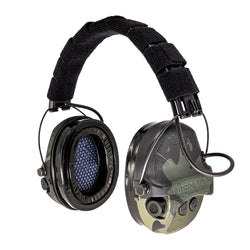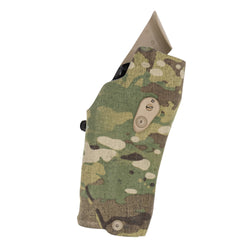The discussion of trigger control is an easy one, right? The basics taught us to correctly line up the sights, focus the front sight on the target and carefully press the trigger. If you do it right, the bullet hits where your front sight was aimed. For many of us it’s just not that easy, and a lot of times improper control of the trigger is the culprit.
There are a variety of reasons that proper trigger function might come harder for some than others. One, and probably the main reason, is size in relation to gun and hand.
Photos in most books or articles on shooting will show proper grip of specific handguns. There is only one problem. Everyone’s hands are different, and we cannot all grip every handgun “properly,” with the barrel being in a straight line with our forearm while maintaining enough finger on the trigger to effectively press it and fire the gun. It’s not always as easy as swapping out stocks (aka grips), although that can sometimes be the easiest fix, especially on revolvers.

Having medium-sized hands, I have to slightly cant some handguns in my hand so I can get enough finger on the trigger to control it properly. Some instructors will say that’s a “no-no,” but there are times when it’s the only way I can make it work.
Example, in my career of law enforcement we could not make any unapproved modifications to our issued handguns. Two manufacturers (H&K and Glock) utilized removable backstraps. In many cases the appropriate spacer could be applied to the benefit to the shooter, but not all. The earlier Beretta did not have adjustments. As with any issued gun, you learned to shoot what you were allowed to carry; that’s it.

In a perfect world we should select a personal defense gun that fits our hand perfectly, keeping that straight line from forearms to barrel with perfect trigger reach. These preferred characteristics should be exhibited by a gun chambered in a sufficient cartridge that we can shoot with precision. Having said that, most of us have a variety of guns we enjoy shooting and not all of them fit as perfectly as we would like.
No matter the fit, we must be able to learn to effectively move the trigger as smoothly as possible and hit what we are aiming at. Good sights are a must on a handgun. A good trigger, and our ability to activate it without unnecessary movement of the gun and sight picture, is imperative.
Single action revolvers are probably the easiest to get to fit correctly. For one, the grip frames are normally smaller and easier to hold. Aftermarket stocks are readily available and, if you don’t mind spending a little extra, you can have folks like RW Grip Frames send you a grip frame that will fit your hand as if it was custom made for you.
For the double action revolver and firing double action with the larger framed guns I usually find it necessary to hold the gun a bit off-center in my hand. This allows me to settle my trigger finger completely on the trigger face with the first joint of my finger contacting the trigger. For me, this allows for proper and deliberate cycling of the trigger. Unfortunately, it also allows for more recoil to be uncomfortably taken by the web of my hand instead of into the palm and that is why I shoot magnum loads in most double action revolvers sparingly.
Grip makers could really help us left-handers out by making grips that mirror the left side, which is normally relieved for reloading and speed loaders, on the right grip panel as well. No matter where you rest your finger on the trigger, on the joint or the pad, the trigger must be pressed in a manner that does not move your properly aligned sights on the target. Proper sight alignment means equal light on each side of the front sight and the front and rear sights being held evenly at the top.

Proper and consistent grip of a handgun is also important for accurate shooting. When firing one accurate shot at a target or game animal I might hold with a bit less pressure than if I was firing multiple rapid shots or double action. I usually hold my handguns with what I describe as a “firm handshake grip” when firing one, carefully placed shot. I prefer a weaver-style stance with a slight bend in my elbows and push forward with my gun hand while pulling towards my body with my support hand and locking my support elbow down towards my side.
When firing rapid follow-up shots, I grip my guns a little tighter to maintain my grip during recoil in hopes of regaining proper sight alignment quickly and pressing the trigger again as smoothly and quickly as possible. One go-by here, especially for double action shooting or for firing multiple shots, is to grip the gun tight enough that your hand starts to shake, then release just enough so the shaking stops.
The muzzle blast from the shot and recoil must not be anticipated. Total focus must remain on the front sight, breath control, and steady pressure on the trigger. No matter what term you prefer relating to trigger movement; “press, pull, stroke,” it must be smooth and consistent.
Experience and quality range time spent with your preferred handgun will reveal the distance to trigger reset on some autoloaders and trigger return when shooting double action revolvers. Trigger return on your double action revolver needs to be as smooth and deliberate as your trigger press when shooting.
Pressing the trigger all the way through until the gun goes off is my preferred method of shooting a double action revolver. Some learn to “stage” the trigger, pressing it and pausing just short of releasing the sear, then administering final pressure on the trigger and firing the gun.
Sheriff Jim Wilson warns against this, and his reasoning is sound. In a stressful situation our fine motor skills can go by the wayside. This could make it very difficult or impossible to “stage” the trigger in a life-or-death situation. The established practice of performing the complete double action trigger press while aligning the sights could be the better option. Opinions of some seem to vary here, so do your homework and decide what’s best for you.

For the single action revolver fan, familiarity with your gun and trigger is no different than other handguns. Practice on the range and during dry fire will make cocking the hammer second nature in the shooting process. Use the support hand to manipulate the hammer for two-handed shooting. Live fire practice is imperative and dry fire practice helps pay dividends towards accurate shooting. Snap caps can be used for revolvers and semi-autos.
Many agree that dry firing (most but not all) center fire revolvers is safe for the gun, not so with most rimfires. Consult your firearms manufacturers or owner’s manual to make sure. I tend to use snap caps in all of my guns. This aids in protecting firing pins and ensures no live ammunition is placed in the gun.
When dry firing keep all live ammunition well away from the gun you are practicing with. I’d suggest having a designated dry firing area where no live ammo is allowed. Check your gun, then check it again to ensure it is empty or loaded only with snap caps.
For the semi-auto shooter there is a new magazine that allows for trigger reset without having to rack the slide. Dry Fire Mag has developed magazines for several popular semi-auto pistols that are simple to use. It resets the trigger allowing for easy, repeat dry fire practice shots. They also have smart DryFireMags with lasers and reactive targets.

One more time for dry fire practice sessions to make certain your practice doesn’t turn into a nightmare. No live ammo! Check it twice, then check it again. Remain focused.
A bullet stopping backstop is an excellent idea as an added layer of safety from a negligent discharge. Body armor can be used if you happen to have it. Some suggest stacks of books, like the end of a full bookshelf, or a couple boxes of copier paper, standing the paper packets on their edges in the box, as a good just-in-case backstop. You would want the bullet to go into the cover area of books or paper, not the edges. The idea is to use something that would effectively stop a bullet if one was inadvertently fired.
Ravelin Group has several varieties of Safe Direction Ballistic Resistant Products worth considering. And while we’re at it lets drive home the Gunsite Academy Firearms Safety Rules.
- ALL guns are always loaded.
- NEVER let the muzzle cover anything which you are not willing to destroy.
- KEEP your finger OFF the trigger until your sights are on the target.
- ALWAYS be sure of your target.
Certain guns will fit our hands and others will require modifications such as grips Then there will be those that no matter what, we can’t modify them to fit our hands perfectly. For them, we must learn to do it wrong, as correctly as possible. In the end, if the bullets are consistently hitting where your sights are aimed at your intended target, you’re doing it right. Through practice and trial and error you will figure out what works best for you. Maybe it really is that easy?









